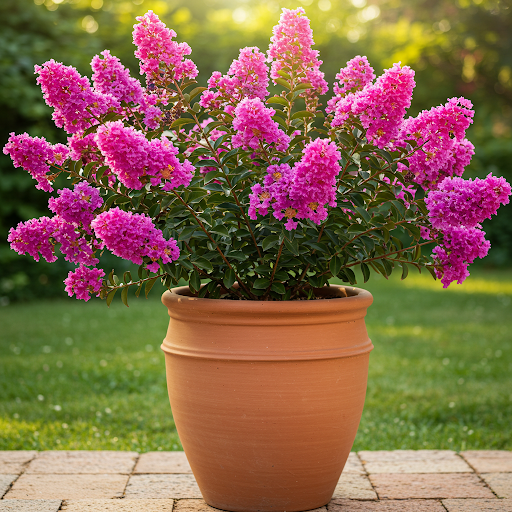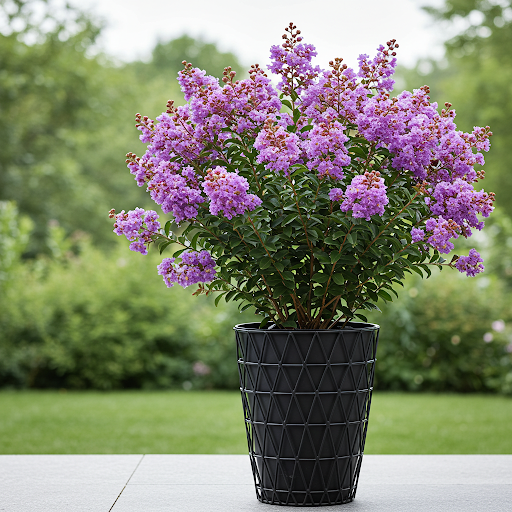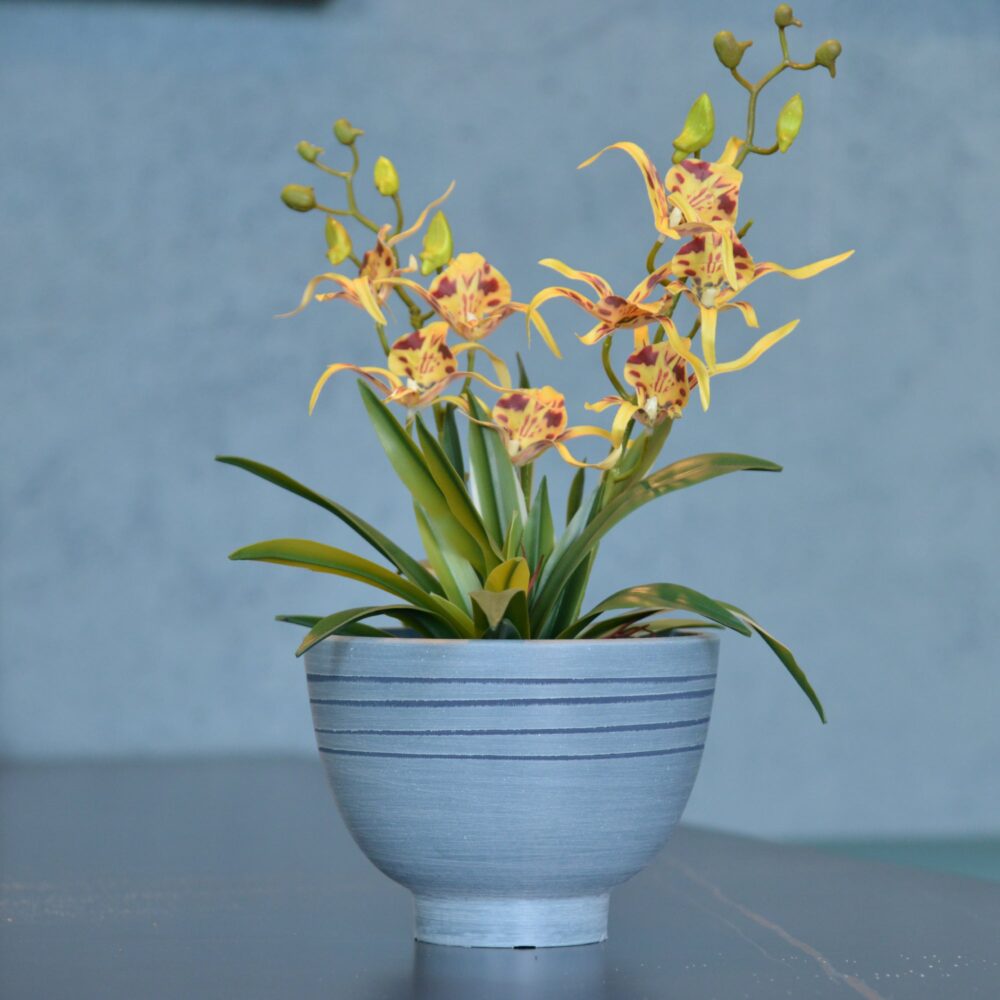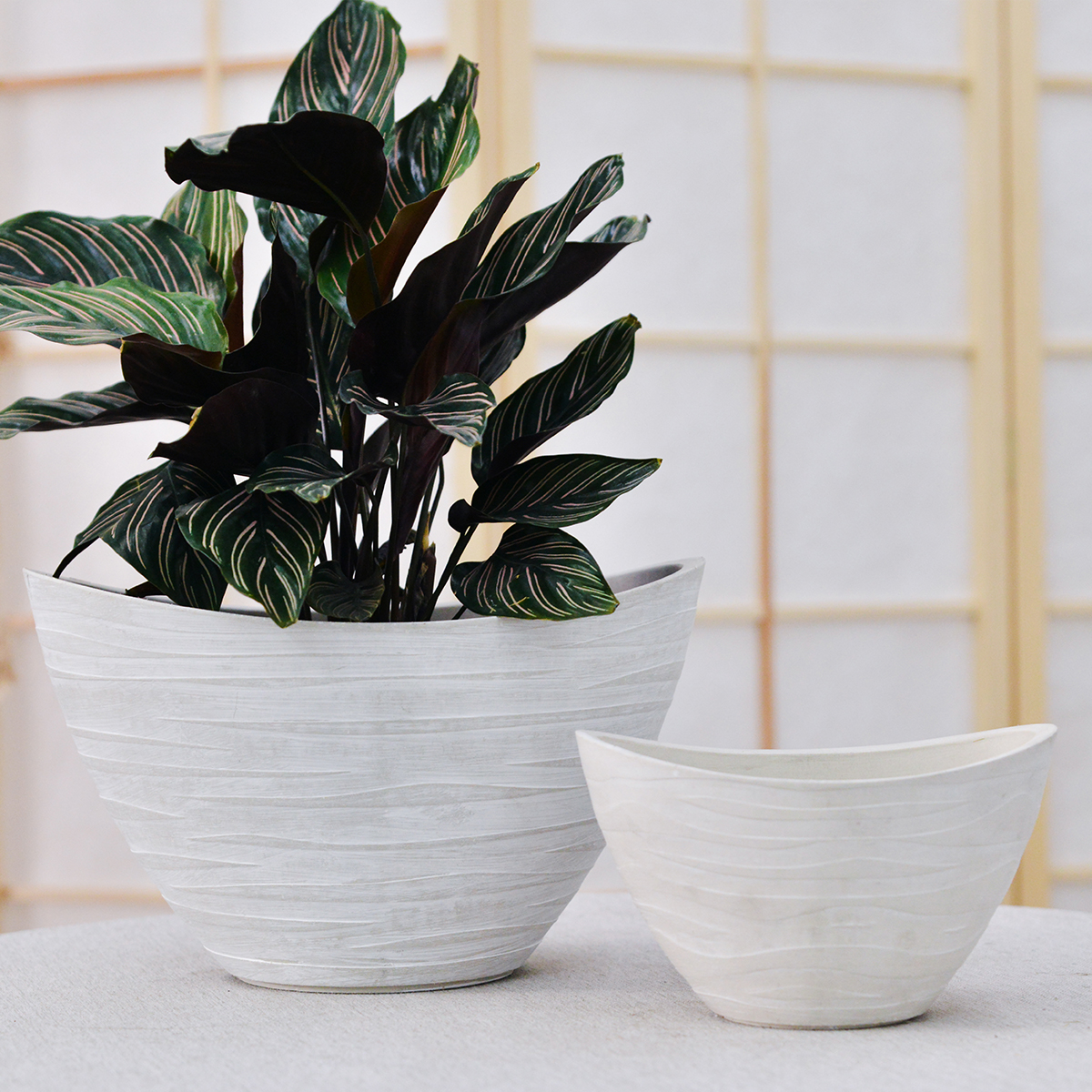Crape Myrtles in Pots: The Ultimate Guide to Growing Stunning Lagerstroemia Outdoors in Containers (Long Bloom & Vibrant Color!)
Want to add a touch of Southern elegance and vibrant summer color to your patio, balcony, or garden? Growing Crape Myrtles (Lagerstroemia indica) in containers is a wonderfully rewarding way to enjoy these beautiful, long-blooming trees, even in limited spaces. Celebrated for their extended summer bloom season with crepe-paper-like flowers, their attractive peeling bark, their vibrant fall foliage color (in some climates), their elegant vase shape, and their adaptability to container gardening, Crape Myrtles are perfect for adding a touch of Southern charm and long-lasting color to your outdoor living areas. This comprehensive guide will provide you with everything you need to know to grow Crape Myrtles successfully in outdoor pots, from selecting the best varieties and containers to mastering essential care techniques for a stunning and vibrant floral display.

Crape Myrtles
What are Crape Myrtles?
Crape Myrtles, scientifically known as Lagerstroemia indica, are deciduous flowering trees or shrubs belonging to the Lythraceae family (Loosestrife family). Native to China, Korea, and the Indian Subcontinent, they are widely cultivated as popular ornamental trees around the world, especially in warm temperate and subtropical climates, prized for their spectacular and long-lasting summer flowers, attractive bark, beautiful fall foliage (in cooler climates), and elegant form. Crape Myrtle trees are characterized by their upright, vase-shaped to rounded growth habit, their smooth, exfoliating bark that peels to reveal mottled patterns and colors on the trunk and branches, their opposite, oval-shaped leaves that turn vibrant shades of red, orange, or yellow in the fall in some climates, and their profuse clusters of crepe-paper-like flowers that bloom in summer and often into fall. Flowers come in a wide range of colors, including pink, red, white, lavender, and purple, and are highly attractive to pollinators. They exhibit a moderate growth rate and can range in size from dwarf shrubs to small trees, depending on the variety and pruning, making them versatile for various landscape uses, including street trees, specimen trees, and container gardening. Crape Myrtles are known for their Southern charm, their heat tolerance, their relatively low maintenance once established, and their ability to provide months of vibrant color in the summer landscape.
Are Crape Myrtles Good for Outdoor Pots?
Yes, Crape Myrtles are surprisingly well-suited for outdoor pots and container gardening, especially dwarf and semi-dwarf varieties. Growing Crape Myrtles in containers is a popular way to enjoy these beautiful trees even in smaller gardens, patios, balconies, or in regions where they might not be fully hardy in the ground. Their adaptability to container culture, manageable size in pots (especially dwarf varieties), long blooming season, beautiful flowers and bark, and relative ease of care make them ideal for container cultivation. Growing Crape Myrtles in pots offers several advantages:
- Ideal for Patios and Balconies: Container gardening allows you to enjoy Crape Myrtles even if you have limited garden space, such as on balconies, patios, or decks. They bring vertical interest and vibrant color to paved areas.
- Portability: Potted Crape Myrtles can be easily moved to optimal locations for sunlight, display, or shelter from extreme weather. You can rearrange them to create stunning focal points or seasonal displays. Bring them indoors to protect from frost in colder climates or from excessive rain in very wet periods.
- Controlled Soil Conditions: Container gardening allows you to provide the specific well-draining, slightly acidic soil mix that Crape Myrtles prefer and control watering and fertilization more precisely, which is important for their health and flowering.
- Design Versatility: Crape Myrtles in pots can be used as standalone specimen trees in decorative pots, placed in pairs flanking doorways or entrances, grouped together for a colorful display, or used to create a focal point in a container garden arrangement. Their elegant form and long bloom season make them versatile for various container gardening styles.
- Pest and Disease Management: Container growing can help reduce some soilborne pest and disease issues that can affect Crape Myrtles planted directly in the ground.
- Size Control (Dwarf Varieties): Growing dwarf or semi-dwarf Crape Myrtle varieties in containers naturally restricts their size, making them more manageable for smaller spaces and preventing them from becoming too large.
- Highlighting Bark and Form: Container growing can showcase the attractive peeling bark and elegant vase shape of Crape Myrtles, especially when pruned to emphasize their form.
Ideal Growing Conditions for Crape Myrtles in Pots:
Types of Crape Myrtles for Pots: When choosing Crape Myrtles for containers, dwarf and semi-dwarf varieties are the most suitable due to their smaller mature size and more manageable growth habit in pots. Standard or larger Crape Myrtle varieties can become too large and unwieldy for long-term container growing. Look for varieties specifically bred for smaller spaces or container culture.
- Dwarf Crape Myrtle Varieties (under 10 feet tall): These are ideal for most containers. Examples include: ‘Pocomoke’ (pink, very dwarf, 3-4 ft), ‘Chickasaw’ (pink, dwarf, 4-5 ft), ‘Tuscarora’ (coral pink, semi-dwarf, 8-10 ft), ‘Sioux’ (pink, semi-dwarf, 8-10 ft), ‘Zuni’ (lavender-pink, semi-dwarf, 8-10 ft), ‘Catawba’ (purple, semi-dwarf, 8-10 ft), ‘Velma’s Royal Delight’ (red, dwarf, 4-6 ft). Check mature size as “dwarf” can still vary.
- Consider Flower Color and Bloom Time: Choose varieties based on your preferred flower color (pink, red, white, lavender, purple) and bloom time (early, mid, late season) to create a desired color scheme and extend the bloom season in your container garden.
- Bark Interest: Some varieties have particularly attractive peeling bark. Consider varieties like ‘Natchez’ (cinnamon-brown bark), ‘Tuscarora’ (cinnamon-gray bark), ‘Sioux’ (tan-brown bark) for added winter interest, although bark may be less prominent on very dwarf container varieties.
Light: Crape Myrtles are full sun lovers. They need at least 6-8 hours of direct sunlight per day, and ideally more, to bloom profusely and develop vibrant flower color. When grown in pots outdoors, position them in the sunniest location possible in your garden or patio. They will tolerate very light afternoon shade, but full sun is best for optimal flowering and overall health. Insufficient sunlight will result in fewer flowers, weaker color, and leggy growth.
Soil: Crape Myrtles prefer well-draining soil that is slightly acidic and moderately fertile. Use a high-quality general-purpose potting mix. Amend potting mix with compost, well-rotted manure, and perlite or vermiculiteto improve fertility, drainage, and aeration. Good drainage is essential to prevent root rot, especially in containers. Crape Myrtles are adaptable to a range of soil types but thrive in slightly acidic to neutral pH (around 6.0-7.0). Avoid heavy, waterlogged soils.
Watering: Crape Myrtles are moderately drought-tolerant once established, but container-grown trees need regular watering, especially during the growing season and hot weather. Water thoroughly when the top inch of soil feels slightly dry. Water deeply until water drains out of the drainage holes. Then, allow the topsoil to slightly dry before watering again. Avoid overwatering and consistently soggy soil, but also avoid prolonged drought stress, especially for young trees and container plants. Watering frequency will depend on weather conditions, pot size, and the tree’s growth stage. Water more frequently during hot, sunny, and windy weather, and less frequently during cooler, cloudier periods and in the dormant season (winter). Reduce watering significantly in winter after leaves have dropped, but don’t let the soil dry out completely.
Temperature: Crape Myrtles are warm-climate trees and thrive in hot summers and mild winters. They are hardy in USDA zones 7-10, and some varieties are hardy to zone 6 with protection. In Singapore’s consistently warm climate, temperature is generally ideal for Crape Myrtles year-round. They are very heat-tolerant and bloom best in warm to hot weather. Protect from frost and freezing temperatures if growing in colder climates (not a concern in Singapore).
Humidity: Crape Myrtles are adaptable to a range of humidity levels and tolerate both moderate and high humidity. Singapore’s humidity is generally well-suited to Crape Myrtles.
Fertilizer: Crape Myrtles benefit from regular fertilization, especially when young and when grown in containers, to support their growth and abundant flowering. Fertilize 2-3 times per year: once in early spring as new growth begins, again in late spring/early summer just before or as flowering starts, and optionally a light fertilization in mid-summer to prolong bloom. Use a balanced fertilizer (e.g., 10-10-10 or 20-20-20) or a fertilizer formulated for flowering trees and shrubs. Follow product label instructions for application rates. Avoid high-nitrogen fertilizers, which can promote leafy growth at the expense of flowers. Mature Crape Myrtles in the ground need less frequent fertilization than container-grown trees. Reduce or stop fertilizing in late summer to allow the tree to prepare for dormancy (if any dormancy occurs in Singapore’s climate).
Choosing the Right Pots for Crape Myrtles:
Suitable Pot Types: Crape Myrtles can be grown in various pot types, but good drainage, stability, and appropriate size are important. Suitable pot types include:
- Terracotta Pots: Terracotta pots are a good choice as they provide good drainage and aeration, helping to prevent overwatering, and offer a classic, elegant look that complements Crape Myrtles. Larger terracotta pots are needed for Crape Myrtles.
- Ceramic Pots (Glazed): Glazed or unglazed ceramic pots can be used, offering a wide range of decorative styles. Ensure they have drainage holes and are large and sturdy enough for a small tree. Choose based on your desired aesthetic and pot size needs.
- Resin Pots (Large and Heavy-Duty): Large, heavy-duty resin pots are a good option as they are lighter than concrete or large terracotta, but can still be made very large and robust, and are durable for outdoor use. Choose UV-resistant resin pots designed for trees or large shrubs.
- Concrete Containers (Very Large and Stable): Very large concrete containers offer maximum stability and durability, which is important for small trees like Crape Myrtles, especially in windy locations. However, they are extremely heavy and difficult to move.
Drainage: Excellent drainage is essential for Crape Myrtles to prevent root rot. Ensure your chosen pot has large drainage holes at the bottom. Avoid pots without drainage holes. Always use a drainage layer at the base of the pot (e.g., a layer of gravel or pot shards) beneath the potting mix to further enhance drainage, especially in larger pots. Elevating pots slightly on pot feet or bricks can also improve drainage and air circulation.
Pot Size: Choose pot sizes appropriate for the Crape Myrtle variety and its expected mature size, as well as your desired display. Crape Myrtles have moderately deep root systems and need room for root development and tree growth.
- Dwarf Crape Myrtle Varieties (up to 5 ft mature height): Start with pots that are at least 18-24 inches in diameter and depth. For mature dwarf varieties, pots that are 24-30 inches in diameter and depth or largerare recommended for long-term growing.
- Semi-Dwarf Crape Myrtle Varieties (8-10 ft mature height): Use pots that are at least 24-30 inches in diameter and depth initially. For mature semi-dwarf varieties, pots that are 30-36 inches in diameter and depth or larger are recommended for long-term growing. Very large pots (48 inches or more) may be needed for older, larger semi-dwarf specimens.
- Depth: Pots should be at least 18-24 inches deep, and ideally 24-30 inches deep or more for larger varieties, to accommodate the root system and provide good soil volume for tree growth.
Stability: Stability is important for container-grown Crape Myrtles, especially as they grow taller and become top-heavy, and in windy locations. Choose heavy pots made of terracotta, ceramic, concrete, or robust, weighted resin/fiberglass. Wider pots are generally more stable than tall, narrow pots. Consider weighting the base of the potwith heavy stones or concrete blocks to further enhance stability, especially for taller varieties or in windy areas.
Color and Style: Choose pot colors and styles that complement the flower colors and elegant form of your Crape Myrtles and your outdoor décor, and enhance their Southern charm and vibrant blooms. Classic terracotta, neutral tones, or elegant dark green or blue pots can create a sophisticated and timeless look, highlighting the colorful Crape Myrtle flowers and attractive bark. Consider the overall style of your patio or balcony and choose pots that harmonize with the surroundings and enhance the desired elegant, colorful garden ambiance.
Essential Care Tips for Thriving Crape Myrtles in Outdoor Pots:
- Watering: “Water Regularly During Growing Season, Allow Topsoil to Slightly Dry Between Waterings”.Water deeply when top inch of soil is slightly dry during growing season. Water thoroughly and ensure good drainage. Allow topsoil to slightly dry between waterings. Avoid overwatering, especially in winter dormancy.
- Sunlight: Provide Full Sun (at least 6-8 Hours Daily for Best Bloom). Full sun is essential for abundant flowering and vibrant color.
- Fertilizing: Fertilize 2-3 Times Per Year During Growing Season with Balanced Fertilizer. Fertilize in early spring, late spring/early summer, and optionally mid-summer. Use a balanced fertilizer or flowering tree/shrub fertilizer. Avoid high-nitrogen fertilizers.
- Pruning (Minimal Pruning, Mostly for Shaping and Deadheading): Crape Myrtles require minimal pruning. Prune mainly for shaping, removing dead or crossing branches, and deadheading spent flower clusters to encourage more blooms. Prune in late winter or early spring before new growth begins. Avoid heavy pruning or “crape murder,” which is unnecessary and disfigures the tree.
- Deadheading (Encourage Reblooming): Deadhead spent flower clusters regularly throughout the blooming season to encourage continuous flowering and prolong the bloom period. Snip off faded flower heads just below the cluster.
- Winter Care (Protect from Frost in Colder Climates, Minimal Care in Singapore): In Singapore’s climate, no winter protection is needed. In colder climates (outside of zones 7-10), potted Crape Myrtles will need winter protection. Move pots to a sheltered location (garage, unheated greenhouse) or provide insulation to the pot and tree to protect from freezing temperatures and frost. Reduce watering significantly in winter dormancy.
- Repotting (Every 2-3 Years or as Needed): Container-grown Crape Myrtles will need repotting every 2-3 years, or when they become root-bound, into progressively larger pots. Repot in late winter or early spring before new growth begins. Refresh the potting mix at repotting time. For very large pots that are difficult to repot, top-dress with fresh potting mix annually.
- Pest and Disease Control: Crape Myrtles are generally relatively pest and disease-resistant. Monitor for aphids, Japanese beetles, or powdery mildew occasionally. Treat with appropriate insecticides or fungicides if needed, but good air circulation and healthy growing conditions are usually sufficient to prevent major problems.
Popular Crape Myrtle Cultivars for Pots (by Flower Color and Size):
Crape Myrtle cultivars offer a wide range of flower colors and plant sizes. Choose dwarf or semi-dwarf varieties for container growing.
- Pink Flowering Dwarf/Semi-Dwarf Crape Myrtles: ‘Pocomoke’ (pink, dwarf), ‘Chickasaw’ (pink, dwarf), ‘Sioux’ (pink, semi-dwarf), ‘Tuscarora’ (coral pink, semi-dwarf), ‘Pink Velour’ (dark pink, dwarf).
- Red Flowering Dwarf/Semi-Dwarf Crape Myrtles: ‘Velma’s Royal Delight’ (red, dwarf), ‘Dynamite’ (red, semi-dwarf), ‘Red Rocket’ (red, semi-dwarf), ‘Ruby Lace’ (red, dwarf).
- White Flowering Dwarf/Semi-Dwarf Crape Myrtles: ‘Purity’ (white, semi-dwarf), ‘Sarah’s Favorite’ (white, semi-dwarf).
- Purple/Lavender Flowering Dwarf/Semi-Dwarf Crape Myrtles: ‘Zuni’ (lavender-pink, semi-dwarf), ‘Catawba’ (purple, semi-dwarf), ‘Twilight’ (dark purple, semi-dwarf).
In Summary:
Growing Crape Myrtles (Lagerstroemia indica) in outdoor pots is a wonderfully rewarding way to add Southern charm and vibrant, long-lasting summer color to your patio, balcony, or garden. Their spectacular crepe-paper flowers, attractive bark, and adaptability to containers make them a perfect choice for container gardeners of all levels, especially those seeking heat-tolerant, low-maintenance, and visually stunning flowering trees for outdoor living spaces. By providing full sun, well-draining potting mix in pots with good drainage, regular watering and fertilization during the growing season, and choosing dwarf or semi-dwarf varieties suited to container culture, you can easily cultivate thriving and spectacularly blooming Crape Myrtles in pots and enjoy their beauty and elegance in your outdoor spaces for many years to come.

Crape Myrtles
For more detailed botanical information and to explore the diverse world of Crape Myrtles, you can visit the Wikipedia page on Lagerstroemia indica.
Important Note: When growing Crape Myrtles in pots, remember that dwarf and semi-dwarf varieties are best suited for container culture. Provide plenty of sunshine, ensure excellent drainage, water regularly during the growing season, and fertilize to encourage abundant blooms. With proper care and a sunny location, your potted Crape Myrtles will reward you with a spectacular and long-lasting display of summer color and Southern elegance in your outdoor spaces!
8 inch/10 inch Planter Indoor Plants, 2 Pack Modern Decorative Plant Pots with Drainage Hole, Cute Bowl Shape Flower Pots
By greenship-seo|2025-04-10T08:03:42+00:00January 9, 2025|Categories: Hand-carving Series|Tags: Decorative Flower Pots, Self-Watering Pots|
HS
By greenship|2024-08-13T06:45:17+00:00August 13, 2024|Categories: Hand-carving Series|
20YB
By greenship|2024-08-16T05:37:57+00:00August 16, 2024|Categories: Hand-carving Series|
Modern Plant Pots丨Planter for Indoor Plants,8 inch or 10 inch Plant Pots with Drainage Hole,Decorative Flower Pots
By greenship-seo|2025-04-10T08:32:55+00:00January 7, 2025|Categories: Hand-carving Series|Tags: Decorative Flower Pots, Self-Watering Pots|
Modern Plant Pots with Drainage – Indoor & Outdoor Use (6″ Widths)
By greenship-seo|2025-04-10T06:29:43+00:00February 6, 2025|Categories: Hand-carving Series|Tags: Decorative Flower Pots|
Planter 6 in W / 8 in W / 12 in W Indoor or Outdoor Plants, Modern Decorative Plant Pots with Drainage Hole, Decorative Flower Pots
By greenship-seo|2025-02-06T13:43:53+00:00January 16, 2025|Categories: Hand-carving Series|Tags: Decorative Flower Pots|






